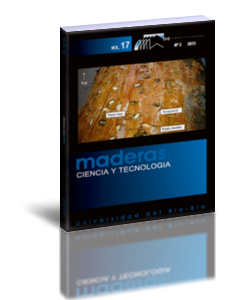Influence of specimen orientation on determination of elesticity in static bending
Keywords:
modulus of elasticity, static bending test, stiffnessAbstract
Wood is a natural material and so many factors interfere in estimation of its physical and mechanical properties. Consequently variability in properties should be taken into account to rationalize its application. Longitudinal modulus of elasticity is one of the main mechanical properties of the material, and its value can be obtained via standardized tests. The aim of this study is to evaluate the influence of test conditions compatible with ABNT NBR 7190:1997 Code requirements to determine modulus of elasticity in static bending. For each of eight species, eight specimens were tested, all of them four times, with the sample oriented on each of its four faces related to load application. Data analysis was performed independently of species and their respective strength class, using hypothesis testing to evaluate influence of specimens’ orientations to determination. It was concluded that specimen orientation is significant in determining modulus of elasticity in static bending according to ABNT NBR 7190:1997. This aspect can lead to a future normative review by the National Committee responsible by redaction of this Code. To represent natural variability of wood in specimens’ volume by only one bending test, values of the modulus of elasticity should be lessened in 8%.
Downloads
Downloads
Published
How to Cite
Issue
Section
License
Copyright (c) 2015 Felipe Hideyoshi Icimoto, Fabiane Salles Ferro, Diego Henrique de Almeida, André Luís Cristoforo, Francisco Antonio Rocco Lahr

This work is licensed under a Creative Commons Attribution 4.0 International License.
Los autores/as conservarán sus derechos de autor y garantizarán a la revista el derecho de primera publicación de su obra, el cuál estará simultáneamente sujeto a la Licencia de Reconocimiento de Creative Commons CC-BY que permite a terceros compartir la obra siempre que se indique su autor y su primera publicación esta revista.
































